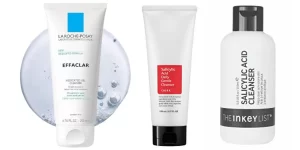
Have you ever looked in the mirror and noticed some discoloration on your skin? It’s pretty common, but not all types of discoloration are the same.
Melasma and hyperpigmentation are two skin conditions that can cause dark patches on your skin, but it’s important to know the difference between the two.
So melasma vs hyperpigmentation, what’s the difference?
Melasma is a type of hyperpigmentation that’s often caused by hormonal changes and typically appears on the face.
Hyperpigmentation on the other hand, can be caused by a variety of factors, such as sun damage or inflammation.

It’s important to distinguish between the two conditions because they have different causes, symptoms, and treatment options.
So, whether you’re dealing with discoloration on your skin or just curious to learn more, keep reading.
Melasma
First things first, what exactly is melasma and what causes it?
Melasma is a type of hyperpigmentation that causes brown or grayish patches to appear on the skin, usually on the face. It happens when the cells that produce pigmentation in the skin (called melanocytes) produce too much pigment.
The excess pigment then accumulates in certain areas, resulting in dark patches.
Some common causes of melasma are hormonal changes (like pregnancy or birth control pills), sun exposure, and genetics. It’s also more common in women and people with darker skin tones.
So, how can you tell if you have melasma?
Well, the most obvious symptom is the appearance of dark patches on your skin. These patches are usually symmetrical, meaning they occur on both sides of the face and can be of different shapes and sizes.
They may also be more noticeable in certain lighting conditions, like when you’re in the sun.
As for risk factors, as I mentioned earlier, women and people with darker skin tones are more likely to develop melasma.
It’s also more common in people who spend a lot of time in the sun or who have a family history of the condition.
So, what can you do if you have melasma?
Treatment options include topical creams, chemical peels, and laser treatments. It’s also important to protect your skin from the sun by wearing sunscreen and a hat when you’re outside.
Overall, melasma can be frustrating to deal with, but there are ways to manage it and improve the appearance of your skin.
5 products to treat melasma
Before diving in, remember that everyone’s skin is different, and what works for one person may not work for you.
And if at any point you’re struggling consult with a dermatologist so they can help you determine the best treatment plan for your skin.
With that said, here are some products that have been shown to be effective for melasma:
#1 SkinCeuticals Discoloration Defense Serum
This serum is formulated with a blend of ingredients that help reduce the appearance of stubborn discoloration and improve overall skin tone.
It contains tranexamic acid, kojic acid, and niacinamide, all of which work together to brighten and even out the skin.
#2 PCA Skin Pigment Gel
This hydroquinone-free gel is a powerhouse of ingredients like azelaic acid, kojic acid, and arbutin that help combat hyperpigmentation and melasma.
Together they work to brighten your skin and even out your complexion!
#3 Obagi Nu-Derm System
This amazing skincare system is tailored specifically for hyperpigmentation, and melasma, with a collection of products that work together to improve your skin.
It includes a cleanser, toner, prescription-strength hydroquinone cream, and sunscreen, all of which work together to improve overall skin tone and reduce the appearance of dark spots.
#4 iS Clinical White Lightening Complex
This powerful, yet lightweight serum is the perfect solution if you’re looking to brighten and even out your skin.
It features a blend of kojic acid, arbutin and bearberry extract which are all known to reduce the effects of hyperpigmentation.
#5 Jan Marini Luminate Face Lotion
This lotion is specially formulated to help reduce hyperpigmentation, like melasma. It utilizes a combination of potent ingredients like alpha-arbutin, retinol, and hexylresorcinol that will help brighten and even out your skin tone.
Hyperpigmentation
This is a broader term that refers to any type of darkening of the skin, not just specifically melasma. So, what causes it?
Hyperpigmentation can be caused by a variety of things, including sun exposure, inflammation, hormonal changes, and skin injuries (like acne or cuts).
Essentially, any type of damage to your skin can trigger an increase in pigment production.
Types of hyperpigmentation
There are several different types of hyperpigmentation, including age spots (which are caused by sun damage), post-inflammatory hyperpigmentation (which can occur after an injury to the skin), and freckles (which are genetic and caused by sun exposure).
Symptoms and characteristics of hyperpigmentation
Symptoms can vary depending on the type, but the most obvious sign is the darkening of the skin. This can occur in small patches or larger areas and can be any shade of brown, from light to dark.
As for risk factors, anyone can develop hyperpigmentation, but it’s more common in people with darker skin and people who spend a lot of time in the sun.
So, what can you do if you have hyperpigmentation?
Treatment options vary depending on the type and severity of the condition, but they can include topical creams, chemical peels, and laser treatments.
Sun protection is also super important for preventing further damage and darkening of the skin.
Hyperpigmentation can be a frustrating condition to deal with, but there are ways to manage it and improve the appearance of your skin.
Just remember, prevention (like wearing sunscreen!) is key to avoiding further damage in the first place.
See also: Does salicylic acid help hyperpigmentation and dark spots?
Melasma vs Hyperpigmentation
Okay, now that we’ve covered the basics of melasma and hyperpigmentation separately, let’s talk about how they differ from each other.
Key differences between melasma and hyperpigmentation
The main difference between the two comes down to the root cause.
Melasma is specifically caused by an increase in pigment production by melanocytes, while hyperpigmentation is a more general term that refers to any type of darkening of the skin.
So, while melasma is a type of hyperpigmentation, not all hyperpigmentation is melasma.
Another difference is the location of the dark patches. Melasma typically appears on the face, while other types of hyperpigmentation can appear anywhere on the body.
How to differentiate between the two conditions
Differentiating between the two conditions can be tricky, but there are a few key factors to look for.
As I mentioned earlier, melasma is often symmetrical, meaning dark patches occur on both sides of the face. It’s also more likely to occur in women and people with darker skin tones.
On the other hand, other types of hyperpigmentation can occur anywhere on the body and aren’t usually symmetrical.
Misconceptions and common mistakes in diagnosis
- One common misconception is that all dark patches on the skin are caused by sun exposure. While sun exposure can certainly contribute to hyperpigmentation, it’s not always the underlying cause. Hormonal changes, inflammation, and skin injuries can all lead to increased pigment production.
Another common mistake in diagnosis is assuming that all dark patches on the skin are melasma.
There are several different types of hyperpigmentation, and it’s important to differentiate between them in order to choose the most effective treatment options.
While melasma and hyperpigmentation may seem similar, they have important differences that can impact their diagnosis and treatment.
If you’re concerned about dark patches on your skin, as always consult with a dermatologist to get a proper diagnosis and treatment plan.
Prevention and Management
Now that we know the differences between melasma and hyperpigmentation, let’s talk about some preventative measures and management strategies you can take to keep your skin looking its best.
First and foremost, sun protection. Both melasma and hyperpigmentation can be exacerbated by sun exposure, so wearing sunscreen with at least SPF 30 every day is helpful. Hats and protective clothing can also help shield your skin from the sun.
See also: The 7 Best La Roche Posay Sunscreen
And if you have melasma, avoiding hormonal triggers (like birth control pills or hormone replacement therapy) can also help prevent flare-ups.
Minimizing inflammation and skin injuries (like acne) can also help reduce the risk of melasma.
Recommended lifestyle changes
In terms of lifestyle changes, a healthy diet and exercise routine can help keep your skin in top shape.
Eating a balanced diet rich in fruits, vegetables, and healthy fats can provide your skin with the nutrients it needs to look and feel its best.
Exercise can also improve circulation and help keep your skin looking radiant.
Available treatment options
As for treatment options, topical creams (like hydroquinone) and chemical peels can be effective for both melasma and hyperpigmentation.
Laser treatments and microdermabrasion are also options for more severe cases.
Some treatments (like chemical peels and lasers) can carry potential complications and risks, like scarring and skin irritation.
Discuss the risks and benefits of each treatment with your dermatologist before undergoing any procedure.
FAQs
Can hyperpigmentation turn into melasma?
Hyperpigmentation and melasma are two separate conditions, although they may look similar on the skin.
And while hyperpigmentation can be a precursor to melasma in some cases, it doesn’t necessarily mean that it will turn into melasma.
Melasma is a more complex condition that involves not only hyperpigmentation but also hormonal factors and UV exposure. It typically appears in larger patches and is more difficult to treat than hyperpigmentation.
That said, if you have hyperpigmentation, it’s important to take preventative measures like wearing sunscreen and avoiding excessive sun exposure to prevent it from developing into more severe forms of hyperpigmentation or other skin conditions like melasma.
If you do develop melasma, it’s a good idea to consult with a dermatologist for a personalized treatment plan.
How do you know if you have melasma?
So, how do you know if you have melasma? Well, the first step is to look for the telltale signs of the condition.
Melasma usually appears as larger patches of discoloration, rather than small spots like freckles or age spots. These patches are usually symmetrical, meaning that they appear on both sides of the face in a similar pattern.
They also tend to be more noticeable after sun exposure, which can trigger the condition.
Also, consider your skin type and history. If you have a history of hyperpigmentation, if you’ve been pregnant, or if you’re taking birth control pills, you may be at higher risk for developing melasma.
Similarly, if you have a darker skin tone or live in a sunny climate, you may be more susceptible to the condition.
If you’re still unsure whether you have melasma, it’s always a good idea to consult with a dermatologist who can help diagnose the condition and recommend treatment.
They may use a Wood’s lamp or perform a biopsy to confirm the diagnosis and rule out other skin conditions that may look similar to melasma.
Remember, if you suspect you have melasma or any other skin condition, don’t hesitate to seek medical advice. With the right diagnosis and treatment, you can help improve the appearance of your skin and regain your confidence.
Final thoughts
Melasma and hyperpigmentation can both cause dark patches and discoloration on the skin. Although they present some similarities, they also have important differences that can influence their diagnosis and treatment.
To choose the most effective treatment option and to prevent potential complications or risks, see a dermatologist and get a proper medical diagnosis.
Taking preventive measures, like sun protection and making lifestyle changes, can also play a key role in managing both.



